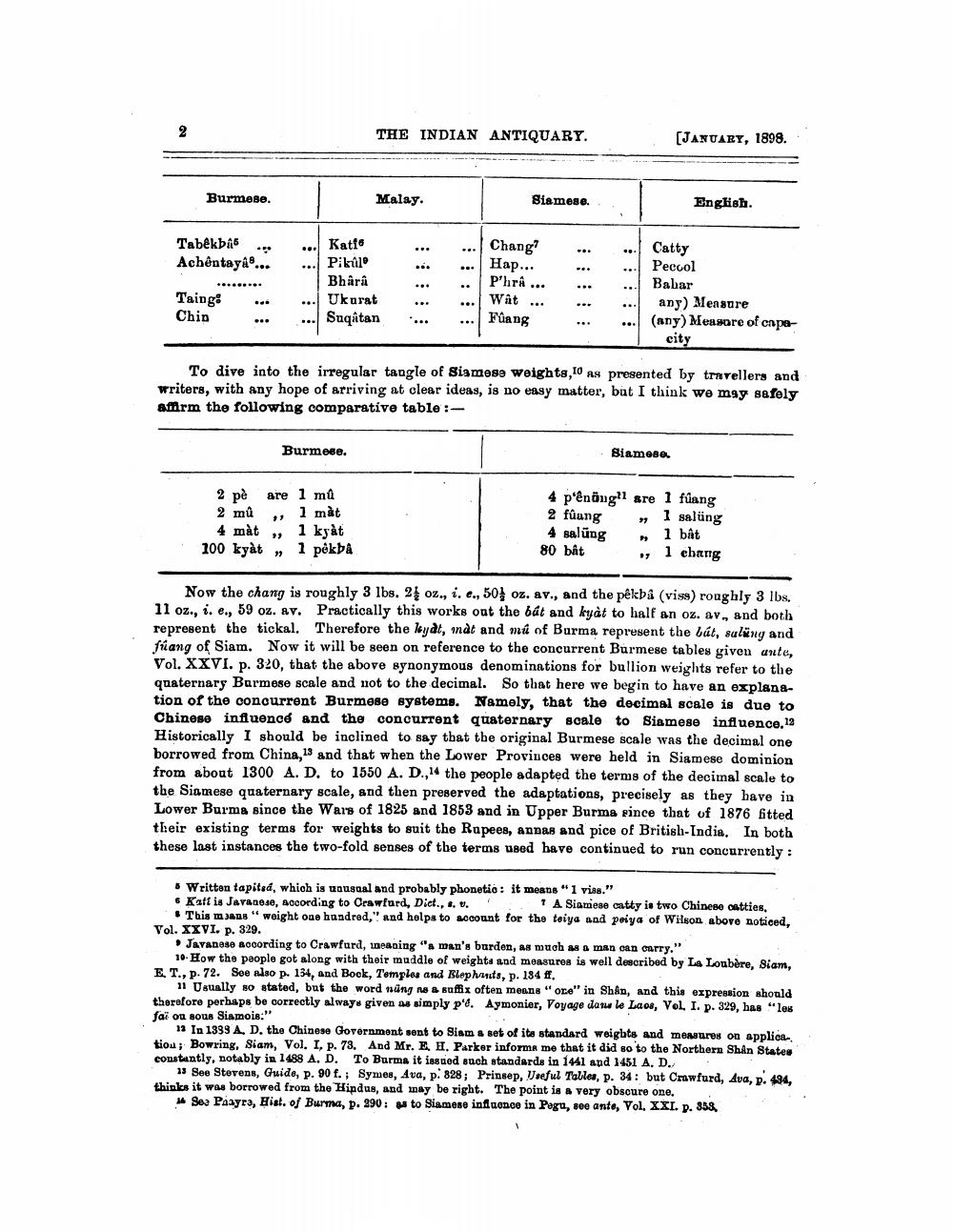Book Title: Indian Antiquary Vol 27 Author(s): Richard Carnac Temple Publisher: Swati Publications View full book textPage 6
________________ THE INDIAN ANTIQUARY. (JANUARY, 1898. Burmese. Malay. Siamese. English. : Tabêkba6.. Achêntayao... : Kati Pikulo Bhara Ukurat Saqatan Chang Hap... Phra ... Wat ... Catty Pecool Babar any) Measure (any) Measore of enpa Taing : Chin Fủa ng : city To dive into the irregular tangle of Siamese weights, 10 as presented by travellers and writers, with any hope of arriving at clear ideas, is no easy matter, but I think we may safely amrm the following comparative table : Burmese. Siamese. 2 pe are 1 mů 2 mů, 1 mat 4 mát ,, 1 kyắt 100 kyat » 1 pêkba 4 p°ênũng 2 fûung 4 Balũng 80 bât bre 1 fũang » 1 salung , 1 bất - 1 chang Now the chang is roughly 3 lbs. 2 oz., i, e., 50 oz. av., and the pêkba (viss) roughly 3 lbs. 11 oz., i. e., 59 oz. Av. Practically this works out the båt and kyat to half an oz. av., and both represent the tickal. Therefore the kyat, îndt and mú of Burma represent the bút, saläng and filang of Siam. Now it will be seen on reference to the concurrent Burmese tables given ante, Vol. XXVI. p. 320, that the above synonymous denominations for bullion weights refer to the quaternary Barmese scale and not to the decimal. So that here we begin to have an explanation of the concurrent Burmese systems. Namely, that the decimal scale is due to Chinese influencs and the concurrent quaternary scale to Siamese influence.12 Historically I should be inclined to say that the original Burmese scale was the decimal one borrowed from China, and that when the Lower Provinces were held in Siamese dominion from about 1300 A. D. to 1550 A. D.,14 the people adapted the terms of the decimal scale to the Siamese quaternary scale, and then preserved the adaptations, precisely as they have in Lower Burma since the Wars of 1825 and 1853 and in Upper Burma since that of 1876 fitted their existing terms for weights to suit the Rapees, Annas and pice of British India. In both these last instances the two-fold senses of the terms used have continued to run concurrently: • Written tapited, which is unusual and probably phonetió: it means "1 vias." 6 Kati is Javanese, according to Crawford, Dict., 1.0. A Siamese catty is two Chinese ostties, This mans "weight one hundred," and helps to socount for the teiya and poiya of Wilson above noticed, Vol. XXVI. p. 329. Javanese according to Crawford, uneasing "a man's burden, as much as a man can carry." 10 How the people got along with their muddle of weights and measuron is well described by La Loubère, Siam, E.T., P. 72. See also p. 134, and Bock, Temples and Elephants, p. 184 ff. 11 Usually so stated, but the word ning ne suffix often means "one" in Shin, and this expression should therefore perhaps be correctly always given as simply p'. Aymonier, Voyage daru le Laos, Vol. I. p. 329, has “les fai ou sous Siamois." 13 In 1399 A, D. the Chinese Government sent to Siam a set of its standard weights and measures on applica. tiou; Bowring, Siam, Vol. I, p. 73. And Mr. E H. Parker informa me that it did so to the Northern Shan States constantly, notably in 1488 A.D. To Burma it issued such standards in 1461 and 1451 A. D. . 13 See Stevens, Guido, p. 90 f. ; Symes, Ava, p. 828 ; Prinsep, Vreful Talle, p. 34: but Crawfurd, Ava, p. 494, thinks it was borrowed from the Hindus, and inay be right. The point is a very obscure one. Sea Paayra, Hist. of Burma, p. 290: w to Siamese influence in Pogu, soe ante, Vol. XXI. p. 85%Page Navigation
1 ... 4 5 6 7 8 9 10 11 12 13 14 15 16 17 18 19 20 21 22 23 24 25 26 27 28 29 30 31 32 33 34 35 36 37 38 39 40 41 42 43 44 45 46 47 48 49 50 51 52 53 54 55 56 57 58 59 60 61 62 ... 404
